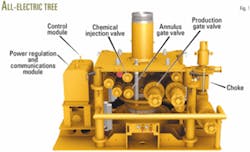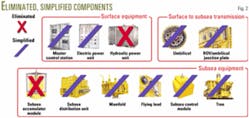Under test at the BP PLC Magnus field in the North Sea is the first all-electric subsea tree (Fig. 1). The Cameron division of Cooper Cameron Corp. envisions that the tree will provide the industry with an alternative to hydraulic or electro-hydraulic controls for actuating valves on subsea completed wells.
Mark Crews, vice-president of technology for Cameron, said "Hydraulics are less responsive and less efficient as production moves into deeper waters and at greater distances from the host facility.
"A DC-powered system is the logical progression of subsea technology. It's less risky and more cost-effective than other hydraulic and battery-operated subsea production systems."
Increasing challenge
Cameron expects the tree to meet the increasing challenges to the industry posed by subsea-completed wells in water depths greater than 10,000 ft, extended well tie-backs that are farther than 15 miles for oil and 100 miles for gas, production from reservoirs with pressures higher than 20,000 psi and vertical depths deeper that 30,000 ft, marginal and submarginal fields, and fields in remote and isolated regions of the world.
According to the company, Cameron's all-electric system eliminates or simplifies topsides equipment, workover control equipment, umbilicals, and controls system components required for subsea trees using hydraulic or electro-hydraulic actuated valves (Fig. 2).
The system has no batteries, no accumulators, and no hydraulics. It does require a high 3,000-5,000 v current. In the system, a single conductor transmits both the power and communications signals, reducing the size of the well umbilical required.
The all-electric tree features an electric subsea control pod and a power and communications module.
On the tree, electrically actuated, are a chemical injection valve, annulus gate valves, production gate valves, and a choke.
"Because there are no hydraulics to be cleaned and maintained, it is a much simpler system. With no risk of hydraulic fluids being released. It's also environmentally friendly," Crews said.
Magnus test
Crews said that the test at the Magnus field automatically cycles the valves daily and will last for about 4-6 months.
In the test, a 1 in., 6-mile reeled coaxial cable provides the power to the tree, but the tree is not installed on an actual well. The tree sits at the base of the platform in 600 ft of water.
Crews added that closing the electric-actuated choke takes 1 min, compared to the 20 min required by a hydraulic actuated choke.


